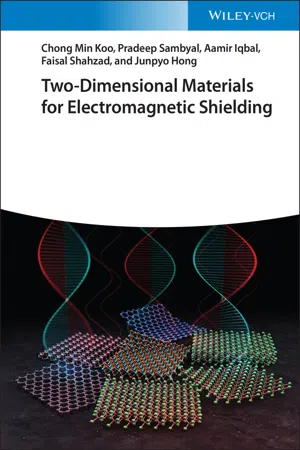
Two-Dimensional Materials for Electromagnetic Shielding
- English
- ePUB (mobile friendly)
- Available on iOS & Android
Two-Dimensional Materials for Electromagnetic Shielding
About this book
Discover a cutting-edge reference on 2D EMI shielding materials for both industrial and academic audiences
Two-Dimensional Materials for Electromagnetic Shielding delivers a thorough and comprehensive examination of all aspects of electromagnetic interference (EMI) shielding and microwave absorption, including fundamentals and applications, as well as emerging 2D materials in the field, like graphene, and MXenes. The book covers basic knowledge on shielding mechanisms and the demanding physical, chemical, and mechanical properties of the 2D materials against betrayed electromagnetic waves.
The benefits of novel 2D materials over existing materials are thoroughly explained and the reader is provided with insight into future developments in shielding materials for highly integrated electrical and electronic equipment. The book offers explanations and in-depth descriptions of graphene and MXenes materials, as well as likely future challenges that will confront practitioners in the field. Ideal for scientists, researchers, and engineers who design novel EMI shielding materials, the book also provides:
- A thorough introduction to electromagnetic field sources and their impact on human beings
- An exploration of EMI shielding mechanism and conversion techniques, including microwave absorption mechanisms and scattering parameter conversion methods
- Discussions of measurements and standards in EMI shielding, including shielding effectiveness measurements
- An examination of graphene, MXenes, and other 2D materials for EMI shielding and microwave absorbing
Perfect for materials scientists, electrochemists, inorganic chemists, physical chemists, and radiation chemists, Two-Dimensional Materials for Electromagnetic Shielding will also earn a place in the libraries of applied physicists and engineering scientists in industry seeking a one-stop reference on cutting-edge 2D electromagnetic interference shielding materials.
Frequently asked questions
- Essential is ideal for learners and professionals who enjoy exploring a wide range of subjects. Access the Essential Library with 800,000+ trusted titles and best-sellers across business, personal growth, and the humanities. Includes unlimited reading time and Standard Read Aloud voice.
- Complete: Perfect for advanced learners and researchers needing full, unrestricted access. Unlock 1.4M+ books across hundreds of subjects, including academic and specialized titles. The Complete Plan also includes advanced features like Premium Read Aloud and Research Assistant.
Please note we cannot support devices running on iOS 13 and Android 7 or earlier. Learn more about using the app.
Information
1
Electromagnetic Interference and Shielding
1.1 Introduction
1.2 Electromagnetic Field Sources and Impact on Human Beings
Table of contents
- Cover
- Table of Contents
- Title Page
- Copyright
- Preface
- 1 Electromagnetic Interference and Shielding
- 2 EMI Shielding Mechanism and Conversion Techniques
- 3 Measurements and Standards
- 4 Graphene and Its Derivative for EMI Shielding
- 5 MXenes as EMI Shielding Materials
- 6 Other 2D Materials
- 7 Conclusion and Perspectives
- Index
- End User License Agreement